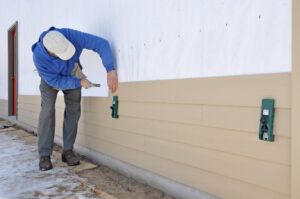What to Expect During Siding Installation

*Updated December 19th, 2025
How to Prepare your House for Siding?
Siding installation is a big project that affects more than the exterior of your home. Most contractors are kind enough to help you prepare your house for siding installation, but there are some steps you can take to make sure the process goes smoothly.
1. Take Care of the Landscaping
Siding installers need access to all sides of your home, so they’ll be up close and personal in your landscaping.
To ensure the least damage, consider trimming trees and bushes to keep them out of the way and avoid them from being stepped on or damaged by materials. Also, cut the grass right before installation to ensure the contractors can easily locate any dropped materials, especially nails.
If you have any removable landscaping, bring them into the garage or another covered area to prevent damage.
2. Remove or Cover any Non-Permanent Pieces Outside
If you have statues, patio furniture, or other accessories, move them to the garage or shed. If they are too heavy to move, or you don’t have room, pull them away from the house as much as possible and cover them.
3. Clear the Driveway
Your siding installers will have a dumpster delivered to your home to remove the old siding and other materials. Be sure there is plenty of room in the driveway and that your cars are out of the garage that you need to drive during installation. Consider parking your cars down the street to avoid unnecessary damage.
4. Remove Pictures and other Wall Décor Inside
You might not think about taking care of the inside of your home, but siding installation gets loud and can shake your home. To prevent anything from breaking, remove pictures and wall décor, and secure any important accessories that might be affected by some shaking.
5. Check for Exterior Obstructions
Inspect the exterior of your home for obstructions like hoses, ladders, or toys. These should be moved to a safe area to prevent accidents and provide clear access for workers.
6. Prepare for Dust and Debris
Siding removal and installation can generate a significant amount of dust and debris. Close all windows and doors tightly and consider covering outdoor furniture or nearby items that can’t be moved to protect them.
7. Inspect and Repair Underlying Issues
Before siding installation begins, inspect your home for any structural issues like rotting wood, mold, or leaks. Addressing these problems beforehand ensures your siding is installed on a solid foundation.
Siding Installation Steps
Siding installation is exciting – it can give your home an entirely new look! Here are the steps you can expect.
1. Old Siding Removal
To install new siding, the old siding must be removed. This is the reason for the dumpster in your driveway. Also, the contractors may pile the old siding on your lawn while removing it but then move it to the dumpster before leaving for the day. If you’re getting wood siding removed, check out 10 creative uses for leftover wood siding.
2. Inspection of Walls
After removing the old siding, installation contractors will inspect the walls to ensure there is no damage underneath the siding. They’ll look for areas that may need repairing or replacing. Installing new siding over bad walls can hinder the siding installation’s success.
Contractors look for the following:
- Water damage
- Mold
- Asbestos
- Damaged sheathing
If there is damage, it can increase the siding installation cost but will ensure the installation is successful, and you get a good return on investment of the new siding.
3. Adding Insulation
After the contractors ensure your walls are in good condition, they’ll add insulation. This helps keep your home cool in the summer and warm in the winter. You may also consider house wrap, as another way to heat and cool your home.
House wrap also protects your home from moisture, preventing mold growth while improving your home’s energy efficiency.
House wrap isn’t required like installation is, but it’s good to consider if there’s room in your budget.
4. Install New Siding
After preparing the walls, insulation, and house wrap, it’s time to install new siding! This is the exciting part but also the noisiest. The contractors will install the new siding first, and then, if it’s a siding that requires painting, they’ll paint it.
This is also the step that includes installing shutters and other features. Typically, contractors complete siding installation first and then paint it.
5. The Final Cleanup
The final cleanup is the most important part of the siding installation process. There will likely be a lot of dust, debris, nails, and other materials that must be picked up and disposed of.
Good contractors will remove all materials, haul away the dumpster, and then clean the area thoroughly so no one would know they were there. This includes using a magnetic nail finder to find any loose nails in the yard, sweeping or blowing any dust or debris, and washing any areas that require it.
How Long Does it Take for Siding Installation?
The time it takes for siding installation depends on a few factors:
- The size of your home – The larger your home is, the longer it takes to replace the siding.
- The crew size – Some siding installation companies have small crews, and others large. The more people working on the home, the faster it can be done.
- Extra work – If the walls underneath the siding need repairing or your siding requires painting, it can extend the length of time required.
Generally, siding installation takes 7 – 14 days but can be more or less depending on the factors of your installation.
Factors that May Hurt your Siding Installation
Choosing a reputable siding installer is important. Do your research to ensure they have good reviews, know what they’re doing, and stand behind their work.
When done improperly, siding installation could have many issues, including the following.
1. Improper Nailing
Good siding installers understand how to install nails so the siding can comfortably expand and contract with hot and cold weather. If the contractor nails the siding too tightly, it doesn’t have room to expand, which can cause it to crack or buckle.
If the siding is nailed too loosely, it can sag during warm temperatures. This is dangerous to the boards underneath, exposing them to moisture, and isn’t aesthetically pleasing.
Believe it or not, proper nailing determines how your siding will look, and any mishaps could affect your home’s appearance.
2. Excessive Overlapping
Siding should normally overlap 1” to 1 ¼” inch; anything more than that can cause the siding to buckle. This is unsightly and exposes your siding to the risk of moisture and potential rot.
3. Not Using Foam-Backed Vinyl Siding
Vinyl siding is a common siding option for a home because it can withstand all temperatures and is affordable. In addition, it has a 74.7% return on investment, and looks good on most homes. However, if the contractor doesn’t use foam-backed siding, you lose some insulation and protection for the home.
4. Using Low Quality Siding
Siding is an investment in your home. While it might seem smarter to cut corners and buy a less expensive siding, you could be doing yourself a disservice. Instead, invest in higher quality siding so it lasts longer and provides your home with more protection.
5. Not Enough Clearance
Siding needs enough clearance at the bottom of your house. If it hits the ground, the siding will be exposed to excessive moisture. Wet siding can lead to rotted wood and major issues, including mold.
6. Inadequate Waterproofing
A crucial part of siding installation is ensuring your home is properly weatherproofed. Failing to install a water-resistant barrier or flashing can lead to water infiltration, causing rot, mold, and structural damage over time.
7. Poor Installation Around Corners and Edges
Corners and edges are more prone to wear and tear. Improper handling of these areas, such as misaligned or loosely secured siding, can compromise the overall integrity and aesthetics of the installation.
8. Incorrect Alignment of Panels
Siding panels must be installed straight and level. Poor alignment not only affects the appearance of your home but can also impact the structural integrity of the siding, leading to gaps, sagging, or other issues.
9. Not Accounting for Ventilation Needs
Failing to maintain adequate ventilation behind the siding can trap moisture, leading to mold growth and rot. Properly installed ventilation ensures your home stays dry and free from potential moisture-related problems.
How to Choose a Siding Installation Contractor
Choosing the right siding contractor is just as important as choosing the right siding. Here are the top factors to consider when hiring a contractor for siding installation.
License and Insurance
Don’t let anyone touch your home that isn’t properly licensed and insured. Work with a contractor that can prove he has the knowledge and experience to install siding and the insurance to protect your home and his contractors. Ask for proof of liability and workman’s comp insurance to ensure you’re protected against any mishaps.
Experience
Ask about a contractor’s experience, but don’t rely on words alone. Ask to see completed jobs, read reviews, or talk to past clients. Ensure they have experience installing the type of siding you want and the knowledge to understand any issues it could experience. Ask about good and bad experiences with the siding to see how they handle problems when they occur.
Siding they Prefer
Contractors often work only with certain siding brands. Ask contractors what they work with and their thoughts on it. Compare this to your research to determine if they are a reputable contractor or just saying what you want to hear to get the job.
Labor Warranty
Contractors don’t control the warranty you get with the siding, but they can provide a warranty on their labor. Ask what they guarantee and for how long. It could be a red flag if they don’t guarantee their workmanship.
Local Office
Ask where the contractor is located. Many contractors are ‘storm chasers’ and don’t have a physical office. They come in and out of areas with bad weather, hoping to get jobs. While they might do a great job, the fact that they aren’t local and won’t be able to provide reviews or a labor warranty is a red flag. Instead, stick with local companies that can provide what you need.
Final Thoughts
Siding installation is a transformative project that not only boosts your home’s curb appeal but also increases its overall value and provides critical protection against the elements. Choosing the right siding and working with a reputable contractor ensures your home remains secure, energy-efficient, and visually appealing for years to come.
Preparation and understanding are key to a smooth and successful installation process. By knowing what to expect, addressing potential challenges ahead of time, and investing in high-quality materials, you can avoid common pitfalls and achieve results that exceed your expectations.
Whether you’re replacing old siding or upgrading to a new material, this project is an investment in the beauty, functionality, and longevity of your home. With careful planning and the right team, siding installation can be a stress-free process that delivers lasting benefits for your property.
FAQ
Is Siding Installation Loud?
Siding installation can potentially be loud, depending on the specific type of siding and the installation process. Some things to keep in mind:
- Vinyl or aluminum siding installation is typically louder than fiber cement or wood siding installation, since it involves more cutting and drilling of the siding materials. The noise from power tools can be significant.
- Removing existing siding can also be loud, as it may involve prying or pounding to remove the siding. This removal process may be noisier than the actual installation of the new siding.
- Additional noise can come from compressors or other equipment if air-powered tools are used. The noise may be more constant but at a lower volume than the intermittent loud noises from power tools.
- To reduce noise, the installation team may be able to use quieter tools, minimize the use of power tools when possible, and work during allowable hours. It’s a good idea to discuss the expected noise level with your siding installer before the work begins.
Taking some preparation steps in advance can help make the noise from siding installation more tolerable, especially if you’re going to be home during the work. And again, talking to your installer about their plans to minimize noise can give you an idea of what to expect. With some planning, the noise should be temporary and the new siding will be worth it!
What Time of Year is Best to Install Siding?
Fall is usually the best time of year for siding installation. The weather is mild, so contractors can get the job done efficiently, and materials may be cheaper to account for the upcoming slower winter months.
Does New Siding Increase Home Value?
New siding can increase your home’s value between $12,500 – $15,000. But, of course, the exact amount depends on the size of the home, the type of siding, and the market value in the area.
Additional Siding Resources
- 14 Signs of Siding Damage
- Tips and Tricks for Wood Siding Maintenance
- Pros and Cons of Different Siding Options

Anna has over six years of experience in the home services and journalism industries and serves as the Content Manager at MyHomePros.com, specializing in making complex home improvement topics like HVAC, roofing, and plumbing accessible to all. With a bachelor’s degree in journalism from Auburn University, she excels in crafting localized, comprehensive guides that cater to homeowners’ unique needs. Living on both coasts of the United States has equipped her with a distinctive perspective, fueling her passion for turning any house into a cherished home through informed, personalized decision-making.








